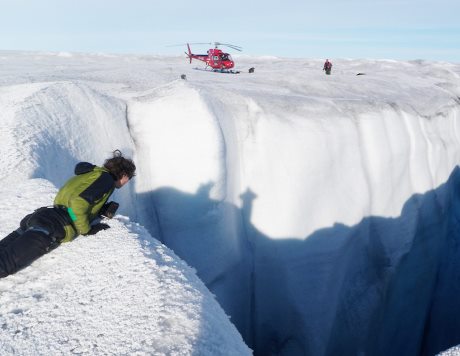Newly published findings from a five-year international project to study conditions at the surface and below the Greenland Ice Sheet will be used in evaluations of the future safety of deep geological repositories over time frames of up to a million years.
 |
| A GAP researcher on the Greenland Ice Sheet (Image: NWMO) |
The Greenland Analogue Project (GAP) has been carried out by the nuclear waste management organizations of Canada, Finland and Sweden. All three countries have experienced multiple ice ages over the last million years - with one occurring every 100,000 years on average - so an understanding of ice sheet conditions is vital in planning for the long-term management of a deep geological repository for used nuclear fuel.
The GAP ran from 2008 to 2013 as a collaborative research project of Canada's Nuclear Waste Management Organizations (NWMO), Finland's Posiva and Sweden's Svensk Kärnbränslehantering AB (SKB), bringing together specialists, research scientists and engineers from six countries. It focused on increasing understanding of how an ice sheet reacts with areas both above and below ground. The Greenland Ice Sheet, on which the studies were conducted, is the second largest in the world and is comparable to ice sheets predicted to extend over both Scandinavia and Canada in future ice ages.
The studies involved direct and indirect observations of ice sheet movement, meltwater runoff, water pressure due to the weight of the sheet, and water transfer from the ice sheet to areas below the ice surface. Boreholes were drilled through the ice sheet to the point of contact with the underlying rock to measure the underground pressure exerted by the ice sheet. A borehole was also drilled at the edge of the sheet at a depth approximating repository conditions to enable hydraulic and chemical monitoring to be carried out. Weather stations monitored climate conditions.
The three partner organizations described the findings of the study as "positive". Posiva's Anne Kontula, research manager and deputy project manager for GAP, said: "Having a greater understanding of the pressure and movement of water at depths associated with deep geological repositories will help further international understanding and best practices associated with the management of used nuclear fuel."
The NWMO's Monique Hobbs said the results from the project provided "never-before-seen information" on the water pressure at the base of an ice sheet, as well as details about where and how much meltwater is generated, at both the surface and the base of the ice sheet, and on how water travels from the surface through the ice.
Lillemor Claesson Liljedahl, GAP Manager for SKB, said the boreholes and results from modelling studies confirmed that water pressure corresponding to 92% of ice thickness accurately describes the average water pressure under the entire ice sheet over a one-year period. "This new information indicates that the conditions under an ice sheet assumed in both earlier and ongoing safety assessments were realistic," she said.
The findings from GAP will be used in comprehensive, detailed studies used to evaluate the safety of deep geological repositories over long time-frames. Liljedahl also said the findings, which had increased the available data on the processes in and under an ice sheet, would be of ongoing value for glaciaologists and climate scientists. Further data gathered from ongoing monitoring of the borehole and from the weather stations will help broaden knowledge of the conditions and processes under the ice, she said.
SKB's application for an integrated system for the final disposal of used nuclear fuel and radioactive waste received approval from the country's Radiation Safety Authority earlier this year. Posiva last year received a licence from the Finnish government to construct an encapsulation plant and final repository for used fuel at Olkiluoto, while the NWMO is conducting a phased process to identify a site for a deep repository for Canada's used nuclear fuel.
Researched and written
by World Nuclear News





_63865.jpg)
_18570.jpg)
_16159.jpg)





